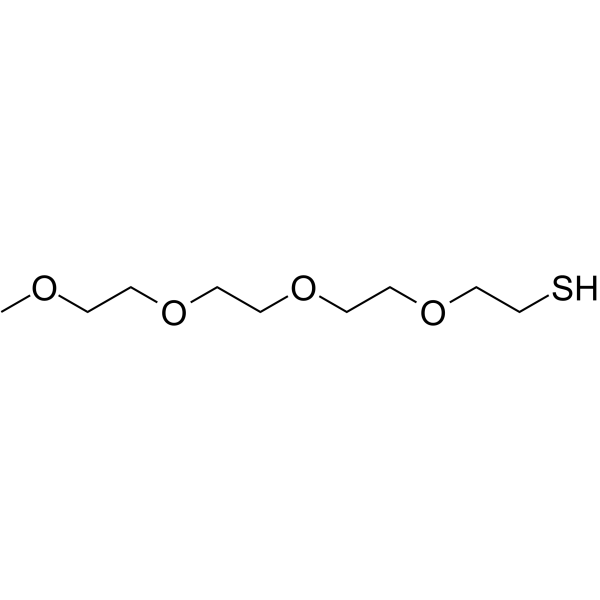
m-PEG4-SH
CAS No. 52190-55-3
m-PEG4-SH( —— )
Catalog No. M26974 CAS No. 52190-55-3
m-PEG4-SH is a PEG-based PROTAC linker that can be used in the synthesis of PROTACs.
Purity : >98% (HPLC)
 COA
COA
 Datasheet
Datasheet
 HNMR
HNMR
 HPLC
HPLC
 MSDS
MSDS
 Handing Instructions
Handing Instructions
| Size | Price / USD | Stock | Quantity |
| 10MG | 29 | Get Quote |


|
| 50MG | 56 | Get Quote |


|
| 100MG | 87 | Get Quote |


|
| 200MG | Get Quote | Get Quote |


|
| 500MG | Get Quote | Get Quote |


|
| 1G | Get Quote | Get Quote |


|
Biological Information
-
Product Namem-PEG4-SH
-
NoteResearch use only, not for human use.
-
Brief Descriptionm-PEG4-SH is a PEG-based PROTAC linker that can be used in the synthesis of PROTACs.
-
Descriptionm-PEG4-SH is a PEG-based PROTAC linker that can be used in the synthesis of PROTACs.(In Vitro):PROTACs contain two different ligands connected by a linker; one is a ligand for an E3 ubiquitin ligase and the other is for the target protein. PROTACs exploit the intracellular ubiquitin-proteasome system to selectively degrade target proteins.
-
In VitroPROTACs contain two different ligands connected by a linker; one is a ligand for an E3 ubiquitin ligase and the other is for the target protein. PROTACs exploit the intracellular ubiquitin-proteasome system to selectively degrade target proteins.
-
In Vivo——
-
Synonyms——
-
PathwayOthers
-
TargetOther Targets
-
RecptoriGluR
-
Research Area——
-
Indication——
Chemical Information
-
CAS Number52190-55-3
-
Formula Weight224.32
-
Molecular FormulaC9H20O4S
-
Purity>98% (HPLC)
-
SolubilityIn Vitro:?DMSO : ≥ 100 mg/mL (445.79 mM)
-
SMILESCOCCOCCOCCOCCS
-
Chemical Name——
Shipping & Storage Information
-
Storage(-20℃)
-
ShippingWith Ice Pack
-
Stability≥ 2 years
Reference
1.H?sli L, et al. Effects of the glutamate analogue AMPA and its interaction with antagonists on cultured rat spinal and brain stem neurones. Neurosci Lett. 1983 Mar 28;36(1):59-62.
molnova catalog



related products
-
dY-V-G
H-D-Tyr-Val-Gly-OH is a catalyst of the synthesis of phenylhydrazones.
-
p-cumylphenol
p-cumylphenol can treat R enal Tubular Cyst Formation in Newborn Rats.
-
PACAP (1-27), human,...
PACAP (1-27), human, ovine, rat TFA (PACAP 1-27 TFA) is an N-terminal fragment of pacap-38 and an effective PACAP receptor antagonist. The IC50s for rat PAC1, rat VPAC1 and human VPAC2 are 3nm, 2nm and 5nm respectively.



 Cart
Cart
 sales@molnova.com
sales@molnova.com


